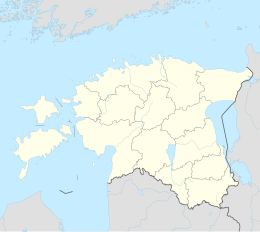Kuivastu
| Kuivastu | ||
| State : |
|
|
| Circle : |
|
|
| Coordinates : | 58 ° 35 ' N , 23 ° 23' E | |
| Time zone : | EET (UTC + 2) | |
|
|
||
Kuivastu (also: Kuiwast; German: Moonsund ) is a port on the east coast of the Estonian island of Muhu (German: Moon ) on Moon Sound . In 2000 the place had 73 inhabitants.
From Kuivastu there is a ferry connection to the mainland to Virtsu (German: Werder ). In winter, when the Moon Sound is frozen deep enough here, the island of Moon can be reached by land vehicles via a route marked on the ice.
Transport policy considerations are being made to connect Moon Island near Kuivastu to the mainland by building a road bridge.
Kuivastu is the birthplace of the Estonian literary and linguist Villem Grünthal-Ridala (1885-1942).
history
At the narrowest point of Moon Sound , there has always been a ferry connection between the island of Moon and the mainland. The first written mention of a port goes back to the middle of the 17th century, when due to the postal ordinance of the Swedish King Charles XI. from January 7, 1677 the establishment of a regular ferry connection for the traffic of passengers and goods was established.
During the Great Northern War , Russian forces landed in Moonsund in August 1710 and then quickly conquered the entire Moonsund Islands . A Russian administration was established. In 1721 Sweden finally ceded the Baltic States to the Russian Empire in the Peace of Nystad .
The Russians expanded and fortified the port in the 18th and 19th centuries. The local post office, which was also responsible for managing the ferry traffic, was housed in an inn for a long time before a new post office was built in 1835. In 1888 the steamship Sirius was put into operation for the ferry service, which replaced the previous sailing ships. From 1902 the steam-powered icebreaker General Surowzew was used, which is why the port facilities were greatly expanded. During the First World War , Moonsund served the Russian fleet as a base to secure the connection between the Gulf of Finland and the Bay of Riga . From here, 1914–1917, work to deepen the fairway in Moon Sound was carried out continuously . In the course of the Battle of Moon Sound on October 17, 1917, the German Navy occupied Moonsund and the entire Moonsund Islands .
When a general mobilization to fight the Red Army was carried out in the course of the Estonian War of Independence in early 1919, a mutiny of recruited Estonians broke out in Moonsund on February 16, 1919 . The mutineers murdered an officer who carried out the mobilization, and two officials, including the manager of the Buxthoeven family's land on Moon and Ösel Oskar Rahr (1876-1919; a brother of Erwin Rahr ). The mutiny was put down on February 18, 1919 by troops loyal to the government.
In the 1920s, the ferry from the Estonian company was Balti Päästeselts operated later by Sergo & Co .
With the annexation of Estonia by the Soviet Union in 1940, ferry traffic came under Soviet administration.
On September 14, 1941, Moonsund and the entire island of Moon were taken by the German 61st Infantry Division . The Baltic States were henceforth part of the Reichskommissariat Ostland for three years .
On September 29, 1944, Soviet amphibious vehicles landed in Moonsund and built the first bridgehead for the reconquest of the Moonsund Islands from the Germans. The area was again incorporated into the Soviet Union.
Even after the Second World War, Moonsund retained its strategic importance.
After Estonia regained independence in 1991, a new port building was completed in 1993. In 1997 the harbor basin was deepened and the landing stages enlarged.
Web links
Individual evidence
- ↑ Kuivastu küla ( Estonian ) eestigiid.ee. Retrieved August 7, 2012.


